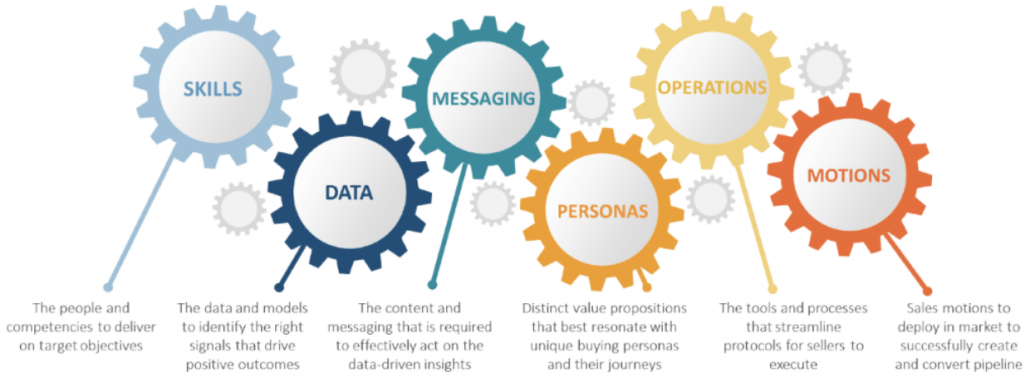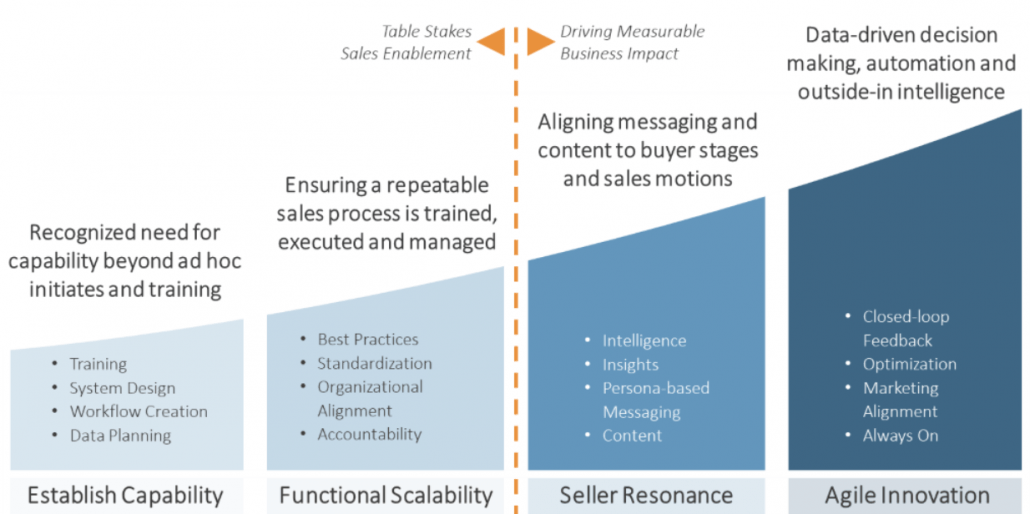Be Bold and Innovate Your Sales Enablement
When it comes to the impact of COVID-19 on sales channels, we’ve seen startling data on the short-term shift in channel usage by both sellers and buyers. Traditional FTF and inside sales channels have taken steep hits in usage — dropping by over 30 percentage points in some instances — which has affected direct and indirect sellers alike.

And this isn’t likely to be a short-term blip either. 79% of sales leaders say that they’re either “very likely” and “somewhat likely” to sustain this commercial and go-to-market model shift 12+ months after COVID-191. That means that Sales Enablement priorities and programs need to permanently shift to higher impact efforts to equip sellers in this new GTM environment.
Now is the time to be bold and innovate your Sales Enablement strategy and programs.
1Source: McKinsey survey: US B2B decision-maker response to COVID-19 crisis
A (More) Comprehensive View of Sales Enablement
We continue to see too many organizations define “Sales Enablement” too narrowly…mainly as the group of people that designs the collateral or delivers training to sales teams or channel partners to help close more deals. Those are critical responsibilities, certainly, but they don’t speak to the broader potential or more comprehensive impact that Sales Enablement can have on driving overall Sales productivity.
While there are certainly many facets to a high performing Sales organization — including talent recruiting, compensation design, territory alignment — we’re seeing Sales Enablement at more innovative companies chartered with relentlessly seeking out and implementing opportunities to equip sellers with more effective techniques across (1) Skills building, (2) Data-Driven best selling practices, (3) differentiated Messaging nuanced by (4) buying Personas, (5) behavior change to achieve Tool adoption, and (6) executing the right selling Motions at the every stage in the buying process.
 Why Agile Sales Enablement?
Why Agile Sales Enablement?
If this new market reality has taught us anything, it’s that Sales Enablement needs to be more AGILE than ever before.
Most Sales organizations are facing four realities today:
- They’re selling to a better informed buyer than ever before;
- Those buyers are expecting superior Customer Experiences from their vendors; business-as-usual sales practices will no longer cut it;
- Demands from Sales leadership to deliver more revenue from tight (or shrinking) budgets is forcing direct and indirect sales channels to be their best; and
- The need to balance the ever-present challenge of scaling programs globally while implementing successfully at the local level.
The implication for Sales Enablement leaders is that they need to capitalize on current disruptions to change their programs to meet four objectives:
- Be prepared to capitalize on the shorter window that buyers are giving sellers;
- Deliver the unique messages and content that speak directly to distinct personas’ wants and needs;
- Launch and run programs that deliver recurring payoff and impact on productivity (not just one and done); and
- Continually establish alignment across all internal customer-facing teams — from Sales to Marketing to Service — to deliver outcomes that meet joint objectives
It’s critical to take action now, during the current economic downturn, because what past recessions have repeatedly shown us is that those who make bold decisions to innovate their operations and how they serve their customers, and appropriately reallocate budgets and resources to accomplish that, end up being the winners on the other side of the recession.
Sales Enablement Maturity: Pursuing Agile Innovation
But what bold decisions should you make and where should you reallocate budget? We use our Sales Enablement Maturity Curve to help our clients determine where their operations are today, and where they can see the biggest gains. Most have already established a foundation of core capabilities (Level 1) and even enjoy (some) repeatable and standardized processes. However, the next step function improvement for most is to systematically use weekly sales performance data and customer insights to feed top performing messaging and content to sellers based on the persona they’re engaging (Level 3) and then automating and optimizing a best practices engine to fuel sales productivity…that’s agile and innovative Sales Enablement (Level 4).
Wherever you may be on your maturity curve, there are 4 principles that you want to follow when building and implementing an innovative, next generation Sales Enablement program:
- Agility: Sales Enablement programs and tactics developed 6 months ago are radically less effective today. Now more than ever you should be using seller performance data, customer engagement insights, and competitive intelligence that you should be collecting weekly to adjust the approaches, messaging, and motions that sellers use to effectively engage buyers in pursuit of better close rates
- Alignment: For Sales Enablement teams to deliver the greatest impact on sales effectiveness, there must be shared objectives across Sales, Marketing, Customer Service and Lines of Business to know “what great looks like” and map a set of programs that can deliver on that. Without this alignment, you risk pursuing conflicting goals resulting in a less impactful role for the Sales Enablement function.
- Always On: Sales Enablement programs today (especially today) need to be evergreen – always on and ever changing with customer preferences and sales channel results. Testing new approaches frequently and learning what works through continuous reporting is the foundation for supporting an always on enablement function that is tightly coupled to your market.
- Activation: This is really where true impact occurs – affecting change in seller behavior. That’s about focusing less on designing and delivering assets for consumption by sales channels and about focusing more on understanding what will drive behavioral change within sellers and reorienting programs to positively affect the process of selling effectively.
3 Practical Starting Points
Sales Enablement has a window of opportunity to be bold and make changes while the competition may be struggling. There are three areas you can focus on to reboot your sales enablement efforts to deliver innovation and effectiveness:
The first is around the customer…building a foundation of what’s changed in how your customers want to interact and what’s now preferred by your buyers. Research can come from insights out of your CRM system as well as quick, primary research. Unlike older approaches to collecting customer research through focus groups or long-term surveys though, this research should be tightly scoped, quickly executed, and recur regularly to feed sellers with insights to be more effective.
The second is around re-setting budgets to place bets on where you can have the biggest impact in both the short-term and long term as you build a platform for innovation. You can’t rely on budgets set at the beginning of this year – the disruption from COVID-19 and the long-term expecting impact that’s believed to have on B2B selling models requires this. Which areas to shift budgets and by how much should be determined, in part, by your placement on the maturity curve.
The third is around timing. Use this disruptive window of time to find exactly what’s working best in this new selling environments, package those best practices, and replicate that across your sales channels with new programs – this really is a tactical example of an agile Sales Enablement program.
Be Bold and Innovate
What we’ve seen in our clients over the past 3-4 months – and growing more every day – is a strong appetite to be bold when rethinking sales enablement and the impact it should have on delivering revenue growth. It’s time to be aggressive (and fast) to make changes to innovate on how you can affect the productivity of your sales channels, not just to survive, but to thrive and emerge stronger by rebooting what sales enablement can deliver.







